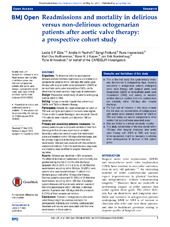| dc.contributor.author | Eide, Leslie Sofia Pareja | en_US |
| dc.contributor.author | Ranhoff, Anette Hylen | en_US |
| dc.contributor.author | Fridlund, Bengt Gotthard Anton | en_US |
| dc.contributor.author | Haaverstad, Rune | en_US |
| dc.contributor.author | Hufthammer, Karl Ove | en_US |
| dc.contributor.author | Kuiper, Karel Kier-Jan | en_US |
| dc.contributor.author | Nordrehaug, Jan Erik | en_US |
| dc.contributor.author | Norekvål, Tone M. | en_US |
| dc.date.accessioned | 2017-06-30T11:56:36Z | |
| dc.date.available | 2017-06-30T11:56:36Z | |
| dc.date.issued | 2016 | |
| dc.Published | Eide LSP, Ranhoff AH, Fridlund BGA, Haaverstad R, Hufthammer KO, Kuiper KK, Nordrehaug JE, Norekvål TM. Readmissions and mortality in delirious versus non-delirious octogenarian patients after aortic valve therapy: A prospective cohort study. BMJ Open. 2016;6:e012683 | eng |
| dc.identifier.issn | 2044-6055 | |
| dc.identifier.uri | https://hdl.handle.net/1956/16131 | |
| dc.description.abstract | Objectives: To determine whether postoperative delirium predicts first-time readmissions and mortality in octogenarian patients within 180 days after aortic valve therapy with surgical aortic valve replacement (SAVR) or transcatheter aortic valve implantation (TAVI), and to determine the most common diagnoses at readmission. Design: Prospective cohort study of patients undergoing elective SAVR or TAVI. Setting: Tertiary university hospital that performs all SAVRs and TAVIs in Western Norway. Participants: Patients 80+ years scheduled for SAVR or TAVI and willing to participate in the study were eligible. Those unable to speak Norwegian were excluded. Overall, 143 patients were included, and data from 136 are presented. Primary and secondary outcome measures: The primary outcome was a composite variable of time from discharge to first all-cause readmission or death. Secondary outcomes were all-cause first readmission alone and mortality within 180 days after discharge, and the primary diagnosis at discharge from first-time readmission. Delirium was assessed with the confusion assessment method. First-time readmissions, diagnoses and mortality were identified in hospital information registries. Results: Delirium was identified in 56% of patients. The effect of delirium on readmissions and mortality was greatest during the first 2 months after discharge (adjusted HR 2.9 (95% CI 1.5 to 5.7)). Of 30 first-time readmissions occurring within 30 days, 24 (80%) were patients who experienced delirium. 1 patient (non-delirium group) died within 30 days after therapy. Delirious patients comprised 35 (64%) of 55 first-time readmissions occurring within 180 days. Circulatory system diseases and injuries were common causes of first-time readmissions within 180 days in delirious patients. 8 patients died 180 days after the procedure; 6 (75%) of them experienced delirium. Conclusions: Delirium in octogenarians after aortic valve therapy might be a serious risk factor for postoperative morbidity and mortality. Cardiovascular disorders and injuries were associated with first-time readmissions in these patients. | en_US |
| dc.language.iso | eng | eng |
| dc.publisher | BMJ | eng |
| dc.rights | Attribution CC BY-NC | eng |
| dc.rights.uri | http://creativecommons.org/licenses/by-nc/4.0/ | eng |
| dc.title | Readmissions and mortality in delirious versus non-delirious octogenarian patients after aortic valve therapy: A prospective cohort study | en_US |
| dc.type | Peer reviewed | |
| dc.type | Journal article | |
| dc.date.updated | 2017-05-12T10:43:46Z | |
| dc.description.version | publishedVersion | en_US |
| dc.rights.holder | Copyright 2016 The Author(s) | |
| dc.identifier.doi | https://doi.org/10.1136/bmjopen-2016-012683 | |
| dc.identifier.cristin | 1403000 | |
| dc.source.journal | BMJ Open | |

